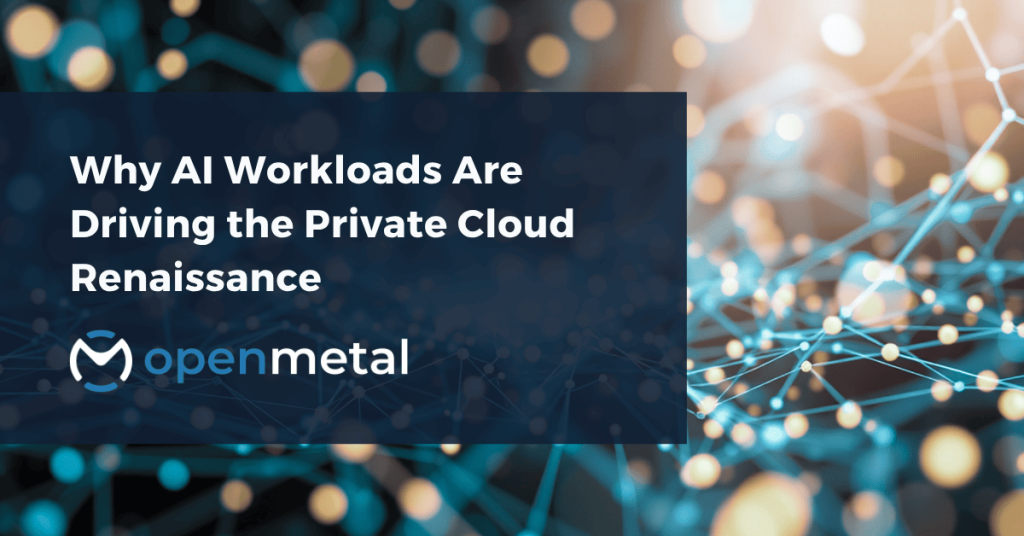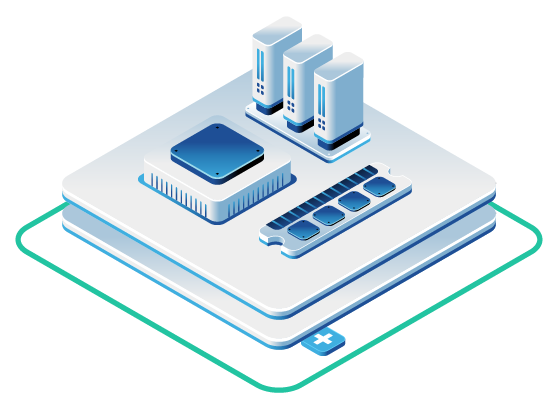
Find out how dedicated GPU infrastructure delivers predictable AI costs.
The OpenMetal team is standing by to assist you with scoping out a fixed-cost model based infrastructure plan to fit your AI requirements, budgets, and timelines.
Artificial intelligence isn’t just transforming software—it’s fundamentally altering infrastructure requirements. While hyperscale public clouds marketed themselves as the universal solution for computational needs, AI and generative AI workloads are exposing significant limitations in their economic models and architectural assumptions. For organizations building AI capabilities, the path forward increasingly points toward private cloud infrastructure that offers performance guarantees, cost predictability, and architectural control.
Why AI/GenAI Workloads Gravitate Toward Private Cloud
Data Sensitivity
AI models require massive datasets for training and fine-tuning. Healthcare organizations training diagnostic models work with protected health information. Financial institutions developing fraud detection systems handle transaction data subject to strict regulations. These datasets can’t simply migrate to shared infrastructure without triggering compliance concerns and regulatory scrutiny.
Private cloud infrastructure keeps sensitive data within dedicated environments where you control access, implement specific security protocols, and demonstrate regulatory adherence. This isn’t theoretical—it’s a requirement for organizations operating under GDPR, HIPAA, PCI-DSS, and similar frameworks where data sovereignty and chain-of-custody documentation are mandatory.
OpenMetal’s support for Intel TDX and SGX confidential computing technologies adds another layer of protection for AI workloads processing highly sensitive data. These hardware-based trusted execution environments ensure that even cloud infrastructure administrators cannot access data during model training or inference operations, meeting the strictest regulatory requirements for healthcare AI, financial fraud detection, and government applications.
Latency & Proximity (Data Gravity)
Data gravity—the tendency for applications and services to be drawn toward where data resides—becomes more pronounced with AI workloads. Training a large language model or processing real-time inference requests generates enormous data movement. When your datasets live in Frankfurt but your GPU resources sit in Virginia, you’re paying both time and money to shuttle terabytes across continents.
Research examining cloud networking costs for data-intensive applications demonstrates that dedicated network links reduce both latency and unpredictable bandwidth charges (Sfiligoi et al.). Private cloud deployments positioned near where your data already exists minimize this friction. You’re not fighting against data gravity—you’re working with it.
GPU Demand & Availability
Public cloud providers ration GPU access through quotas, time-slicing, and oversubscription. According to Gartner forecasts, organizations will spend approximately $202 billion on AI servers in 2025, yet GPU supply constraints will persist for years. Service providers alone are projected to invest nearly $100 billion in AI-specific servers this year, with demand consistently exceeding supply.
This scarcity creates a fundamental problem: when you need H100 GPUs for model training, you’re competing with every other tenant for limited resources. Workloads get queued. Experiments get delayed. Production inference requests face inconsistent performance.
OpenMetal provides dedicated GPU servers and clusters designed specifically for organizations serious about AI and GenAI workloads. Unlike hyperscalers that ration GPU resources through quotas, time-slicing, or oversubscription, OpenMetal delivers full access to NVIDIA A100s, H100s, and beyond. This ensures predictable, uncompromised performance for training, fine-tuning, and inference. Enterprises gain complete control over their GPU resources, avoiding bottlenecks and accelerating experimentation cycles.
Cost Predictability
AI workloads expose the economic vulnerabilities of usage-based billing. Training runs consume thousands of GPU-hours. Inference services generate constant data egress. Storage requirements balloon as you accumulate training datasets, model checkpoints, and versioned artifacts.
A UK Competition and Markets Authority investigation found that egress fees—charges for moving data out of cloud environments—can represent substantial portions of total cloud spending. Their analysis revealed that for some customers, egress costs alone could reach double-digit percentages of annual cloud budgets. These fees accumulate particularly fast with AI workloads due to continuous data movement between training environments, model registries, and inference endpoints.
Academic research on cloud storage costs identifies similar patterns: the apparent simplicity of per-GB pricing masks hidden expenses that emerge at scale. Organizations discover their monthly bills fluctuating unpredictably based on factors outside their direct control.
Unlike public cloud providers that rely on opaque, usage-based billing, OpenMetal uses a fixed-cost pricing model. There are no hidden licensing fees and no unpredictable egress charges. Organizations know exactly what their infrastructure will cost month-to-month, which simplifies budgeting and long-term ROI planning. This transparent cost model is particularly important for AI workloads, where data movement, GPU usage, and scaling can cause hyperscaler bills to balloon without warning.
Consider a concrete example: when training a large language model that generates 50TB of checkpoint data monthly and serves 10 million inference requests producing 2TB of egress traffic, fixed pricing eliminates the budget uncertainty that plagues hyperscaler deployments. These same workloads on usage-based infrastructure could generate wildly varying monthly bills depending on training iterations, data transfer patterns, and inference demand spikes.
Networking Performance & Control
AI inference services demand consistent low-latency responses. Model training jobs require high-throughput connections between GPU nodes and storage systems. Quantitative studies comparing on-premise and cloud execution of scientific workflows demonstrate that networking performance significantly impacts total execution time and cost (Juhasz et al.).
Public cloud shared networking introduces variability. One tenant’s spike in bandwidth consumption affects neighboring workloads. Traffic shaping policies prioritize certain types of traffic over others. You lack visibility into why performance degrades during specific hours.
Networking is a core differentiator. OpenMetal provides dual 10 Gbps network interfaces totaling 20 Gbps throughput per server, along with VLANs with VXLAN support, included private traffic, predictable 95th percentile egress pricing, DDoS protection, and granular IP management including IPMI access.
This dual 10 Gbps architecture becomes particularly important for AI workloads that require simultaneous high-throughput operations—one interface can handle dataset ingestion from storage while the other manages inter-GPU communication for distributed training. The 20 Gbps combined throughput ensures that moving large training datasets across GPU nodes or synchronizing model checkpoints doesn’t become a bottleneck. VLAN and VXLAN support enables isolated, high-performance networks between training infrastructure and storage systems, preventing interference during critical operations like gradient synchronization in distributed training runs.
These features ensure enterprises get not only consistent low-latency performance for AI inference workloads, but also protection against unexpected bandwidth costs and external threats. For data-intensive AI applications, where datasets often need to be accessed or shared rapidly across environments, OpenMetal’s networking architecture delivers the predictability and control hyperscalers cannot.
The OpenMetal Advantage for AI/GenAI
Compute: Dedicated GPU Resources
OpenMetal’s approach to GPU infrastructure eliminates the resource contention inherent in multitenant environments. When you provision H100 GPUs, you receive full, unshared access to those processors. No time-slicing. No quota negotiations. No competing with other tenants for available capacity.
This matters for both training and inference. Model training jobs can run continuously without interruption. Inference endpoints maintain consistent response times regardless of external load. You control the hardware, which means you control the performance characteristics of your AI applications.
Storage: Flexible, High-Performance Ceph
Storage is powered by Ceph, an open-source, software-defined storage platform that enables both high performance and flexibility within the same cluster. OpenMetal offers NVMe-based tiers for ultra-fast data access, which is necessary when dealing with large datasets for training, as well as HDD tiers with erasure coding for economical long-term storage. This unified approach allows organizations to scale storage based on workload requirements while balancing cost efficiency and performance, without having to manage multiple, siloed storage systems.
AI workloads benefit from this architecture in concrete ways. Training datasets requiring frequent random access live on NVMe storage for maximum throughput. Archived model checkpoints and historical training data reside on cost-optimized HDD storage. The same cluster handles both workload types without forcing you to maintain separate storage infrastructures.
Deployment Speed and Global Reach
Deployment speed is another major differentiator. With OpenMetal, organizations can deploy a complete OpenStack-powered private cloud in hours, compared to the multi-week timelines typical of traditional providers. This agility allows fast-moving AI teams to experiment, test, and iterate without being held back by infrastructure delays.
Finally, OpenMetal provides global reach with local data gravity. With data centers across the US, EU, and Asia, organizations can strategically place their private clouds close to where their data resides. This minimizes latency, reduces bandwidth costs, and helps meet data sovereignty requirements while still supporting global operations.
Hybrid by Design
All of this is delivered with a hybrid-by-design philosophy. OpenMetal private clouds can interconnect seamlessly with public cloud environments, allowing organizations to keep their most sensitive or GPU-heavy workloads in dedicated, controlled infrastructure while using hyperscaler elasticity for burst capacity. This approach gives enterprises the best of both worlds: control where it matters, flexibility where it counts.
Unique Viewpoint: AI as the Stress Test for Cloud Economics
OpenMetal’s perspective is that AI workloads represent the ultimate stress test for cloud economics and infrastructure models. Unlike traditional applications that tolerate shared resources, variable latency, and unpredictable costs, AI demands a fundamentally different approach.
Public clouds were architected for elastic, commodity workloads—web applications that scale horizontally, batch processing jobs with flexible timing, development environments where occasional performance variance is acceptable. AI changes this equation completely. Training runs can’t tolerate GPU interruptions. Inference services can’t accept inconsistent response times. Data movement at AI scale exposes the real costs hidden in hyperscaler pricing structures.
The future isn’t public versus private—it’s hybrid with a private-first anchor. By placing sensitive, GPU-intensive, and latency-critical workloads on dedicated private cloud infrastructure, you achieve both compliance and performance consistency. At the same time, you maintain the ability to use public cloud ecosystems for burst capacity, specialized services, and global reach.
This viewpoint directly challenges the narrative that everything belongs in hyperscale clouds. Instead, AI exposes the weaknesses in hyperscaler models, particularly around egress pricing, GPU availability, and networking performance. For enterprises, the strategic play isn’t chasing hyperscalers but adopting infrastructure that balances control and flexibility.
The Strategic Play: Hybrid by Design
The realistic path forward for most enterprises isn’t abandoning public clouds entirely—it’s architecting strategically around their limitations. A hybrid approach with private cloud as the foundation addresses AI’s specific demands while preserving access to public cloud services where they genuinely add value.
Consider a financial services firm developing fraud detection models. Training happens on dedicated GPU infrastructure in their private cloud, where sensitive transaction data never leaves their controlled environment. The trained models deploy to inference endpoints in the same private cloud, ensuring consistent sub-100ms response times. Meanwhile, they use public cloud services for non-sensitive workloads like employee productivity tools or website hosting.
This architecture isn’t theoretical. It’s how organizations navigate the reality that AI workloads have different requirements than traditional applications. OpenMetal enables this model by providing OpenStack-based private clouds that interconnect with public cloud environments through standard networking protocols. You’re not locked into a single vendor’s ecosystem, and you’re not forced to compromise on performance or cost predictability for your most demanding workloads.
Conclusion
AI workloads are revealing fundamental limitations in hyperscale cloud economics and shared infrastructure models. The combination of massive datasets, GPU resource constraints, unpredictable costs, and demanding performance requirements makes traditional public cloud approaches increasingly untenable for organizations serious about AI capabilities.
Hosted private cloud with OpenMetal delivers what enterprises actually need: dedicated GPU resources without quotas or time-slicing, storage systems that balance performance and cost, networking with predictable latency and bandwidth costs, transparent fixed pricing, and deployment timelines measured in hours instead of weeks.
This isn’t about rejecting public clouds entirely—it’s about placing your most important workloads on infrastructure designed for their specific requirements. AI demands performance, control, and predictability. OpenMetal’s private cloud platform delivers exactly that, while maintaining the flexibility to integrate with public cloud services where appropriate.
The infrastructure decisions you make today will determine whether your AI initiatives succeed or stall. Organizations choosing hosted private cloud aren’t retreating from innovation—they’re building the foundation that makes innovation possible.
Tired of competing for GPU quotas and watching egress fees consume your AI budget? OpenMetal delivers the performance guarantees and cost predictability your AI workloads demand. Talk to our infrastructure specialists about building your private cloud foundation.
Read More Blog Posts
Works Cited
- Gartner. “AI Spurs 25% Surge in Data Center Systems Spending.” Network World, 2024, www.networkworld.com/article/2518098/gartner-ai-spurs-25-surge-in-data-center-systems-spending.html.
- Juhasz, Zoltan, et al. “Quantitative Cost Comparison of On-Premise and Cloud Execution of Scientific Workflows.” Cluster Computing, Springer, 2020, link.springer.com/article/10.1007/s10586-020-03141-y.
- Sfiligoi, Igor, et al. “Managing Cloud Networking Costs for Data-Intensive Applications by Provisioning Dedicated Network Links.” arXiv, 2021, arxiv.org/abs/2104.06913.
- UK Competition and Markets Authority. “Egress Fees Working Paper.” Cloud Services Market Investigation, May 2024, assets.publishing.service.gov.uk/media/664f2556993111924d9d3aa8/240521_-Egress_Fees_.pdf.
- “Cloud Storage Cost: A Taxonomy and Survey.” ResearchGate, Springer, 2024, www.researchgate.net/publication/380853346_Cloud_storage_cost_a_taxonomy_and_survey.


































